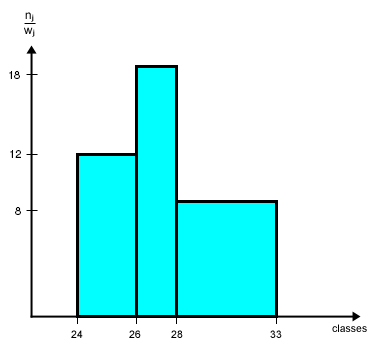Teaching:TUW - UE InfoVis WS 2007/08 - Gruppe 07 - Aufgabe 1 - Histogram: Difference between revisions
No edit summary |
No edit summary |
||
| Line 8: | Line 8: | ||
= Explanation = | = Explanation = | ||
A histogram is a representation of a frequency distribution by using rectangles. The width of the rectangle (x axis) represents | A histogram is a representation of a frequency distribution by using rectangles. The width of the rectangle (x-axis) represents | ||
different values included into one class whereas the | different values included into one class whereas the area of each column (not it's height) specifies how many data-elements of each class occur in the total data set (absolute frequency). Histograms are widely being used in statistics but we can also find them in practical appliances in our everyday life as well, e.g. digital photography. | ||
= Example = | = Example = | ||
As an example we consider values given from the table below to create a histogram (right image). The data derived from the first column of the table shows the class affiliation. According to the table values these classes are aligned along the x-axis of the histogram. | As an example we consider values given from the table below to create a histogram (right image). The data derived from the first column of the table shows the class affiliation. According to the table values these classes are aligned along the x-axis of the histogram. The heigth of each histogram bar (frequency density) can be obtained by dividing the absolute frequenzy values (second column) by the corresponding class intervals. The results for each class are then printed along the y-axis of the histogram. Once this is properly done, the histogram shows the amount of frequency according to any of the classes. Hence the histogram is a powerful visualisation that can make information accessable in just a few seconds, considering that the table on the left side is representing the same information, it is easy to understand the power of graphical visualisation. | ||
<table style="height:16px" border="0"> | <table style="height:16px" border="0"> | ||
Revision as of 11:42, 8 November 2007
Definitions
Explanation
A histogram is a representation of a frequency distribution by using rectangles. The width of the rectangle (x-axis) represents different values included into one class whereas the area of each column (not it's height) specifies how many data-elements of each class occur in the total data set (absolute frequency). Histograms are widely being used in statistics but we can also find them in practical appliances in our everyday life as well, e.g. digital photography.
Example
As an example we consider values given from the table below to create a histogram (right image). The data derived from the first column of the table shows the class affiliation. According to the table values these classes are aligned along the x-axis of the histogram. The heigth of each histogram bar (frequency density) can be obtained by dividing the absolute frequenzy values (second column) by the corresponding class intervals. The results for each class are then printed along the y-axis of the histogram. Once this is properly done, the histogram shows the amount of frequency according to any of the classes. Hence the histogram is a powerful visualisation that can make information accessable in just a few seconds, considering that the table on the left side is representing the same information, it is easy to understand the power of graphical visualisation.
Related Links
References
- [Wikipedia, 2007] Wikipedia, Histogram. Retrieved at: November 01, 2007. http://en.wikipedia.org/wiki/Histogram
- [Wallgreen et al., 1996] Anders Wallgreen, Britt Wallgreen, Rolf Persson, Ulf Jorner and Jan-Aage Haaland. Graphing Statistics & Data: Creating Better Charts. SAGE Publications, Thousand Oaks, London, New Delhi, 1996.
- [Evans, 2004] Geraint Evans, Histograms. CensusAtScool. Retrieved at: November 08, 2007. http://www.censusatschool.ntu.ac.uk/files/histogram.pdf
